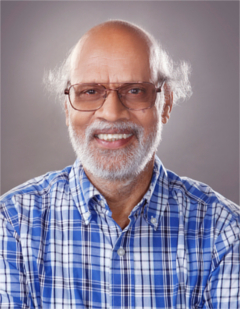
In nuclear astrophysics, the rapid neutron-capture process, also known as the r-process, is a set of nuclear reactions that is responsible for the creation of approximately half of the atomic nuclei heavier than iron, the "heavy elements", with the other half produced by the p-process and s-process. The r-process usually synthesizes the most neutron-rich stable isotopes of each heavy element. The r-process can typically synthesize the heaviest four isotopes of every heavy element; of these, the heavier two are called r-only nuclei because they are created exclusively via the r-process. Abundance peaks for the r-process occur near mass numbers A = 82, A = 130 and A = 196.
Darmstadtium (110Ds) is a synthetic element, and thus a standard atomic weight cannot be given. Like all synthetic elements, it has no stable isotopes. The first isotope to be synthesized was 269Ds in 1994. There are 11 known radioisotopes from 267Ds to 281Ds and 2 or 3 known isomers. The longest-lived isotope is 281Ds with a half-life of 14 seconds.

The nuclear drip line is the boundary beyond which atomic nuclei are unbound with respect to the emission of a proton or neutron.
p-nuclei (p stands for proton-rich) are certain proton-rich, naturally occurring isotopes of some elements between selenium and mercury inclusive which cannot be produced in either the s- or the r-process.

Hendrik Schatz is a professor of Nuclear Astrophysics at Michigan State University. He earned his Diploma from the University of Karlsruhe in 1993, and his PhD from the University of Heidelberg in 1997 after completing his thesis work at the University of Notre Dame. He is one of the Principal Investigators for the Joint Institute for Nuclear Astrophysics and is a leading expert on nuclear astrophysics,. Schatz also serves the science advisory committees for the Facility for Rare Isotope Beams and GSI. Hendrik's primary field of expertise is Type I X-ray Bursts. His most notable contribution to this field is the discovery of the SnTeSb-cycle. Hendrik was featured in Science magazine November 22, 2002 for his work on experimental nuclear astrophysics. Hendrik has also contributed to Physics Today.

The light-front quantization of quantum field theories provides a useful alternative to ordinary equal-time quantization. In particular, it can lead to a relativistic description of bound systems in terms of quantum-mechanical wave functions. The quantization is based on the choice of light-front coordinates, where plays the role of time and the corresponding spatial coordinate is . Here, is the ordinary time, is a Cartesian coordinate, and is the speed of light. The other two Cartesian coordinates, and , are untouched and often called transverse or perpendicular, denoted by symbols of the type . The choice of the frame of reference where the time and -axis are defined can be left unspecified in an exactly soluble relativistic theory, but in practical calculations some choices may be more suitable than others. The basic formalism is discussed elsewhere.

Daya Shankar Kulshreshtha is an Indian theoretical physicist, specializing in formal aspects of quantum field theory, string theory, supersymmetry, supergravity and superstring theory, Dirac's instant-form and light-front quantization of field theories and D-brane actions. His work on the models of gravity focuses on the studies of charged compact boson stars and boson shells.
Ani Aprahamian is a Lebanese-born Armenian-American nuclear physicist. She has taught at the University of Notre Dame since 1989. She is currently Freimann Professor of Physics at Notre Dame. She has been director of the Alikhanyan National Science Laboratory in Armenia since April 2018, the first woman to hold the position.
Christopher John Pethick is a British theoretical physicist, specializing in many-body theory, ultra-cold atomic gases, and the physics of neutron stars and stellar collapse.
Felix Hans Boehm was a Swiss-American experimental physicist, known for his research on weak interactions, parity violation, and neutrino physics.
Blayne Ryan Heckel is an American experimental physicist, known for his research involving precision measurements in atomic physics and gravitational physics. He is now a professor emeritus at the University of Washington in Seattle.
Jens Horst Gundlach is a German physicist.
Steven Michael Errede is an American experimental physicist, known for his leadership in the collaboration that experimentally confirmed the existence of the top quark.
James Wellington Truran Jr. was an American physicist, known for his research in nuclear astrophysics.
Claus E. Rolfs is a German experimental physicist, known for his laboratory research related to nuclear astrophysics. He is a co-initiator of Nuclei in the Cosmos.
Madappa Prakash is an Indian-American nuclear physicist and astrophysicist, known for his research on the physics of neutron stars and heavy-ion collisions.
James "Jim" Ricker Wilson was an American theoretical physicist, known for his pioneering research in numerical relativity and numerical relativistic hydrodynamics.
George Michael Fuller is an American theoretical physicist, known for his research on nuclear astrophysics involving weak interactions, neutrino flavor-mixing, and quark matter, as well as the hypothetical nuclear matter.
Daniel S. Akerib is an American particle physicist and astrophysicist. He was elected in 2008 a fellow of the American Physical Society (APS).

Germán Sierra is a Spanish theoretical physicist, author, and academic. He is Professor of Research at the Institute of Theoretical Physics Autonomous University of Madrid-Spanish National Research Council.





